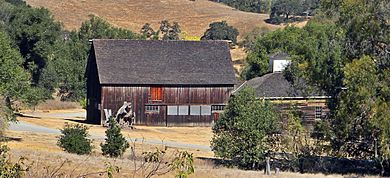Rancho Olómpali facts for kids
Rancho Olómpali was a very large piece of land, about 8,877 acres, given out by the Mexican government. This happened in 1834 in what is now Marin County, California. The land was given to Camilo Ynitia, who was the son of a Coast Miwok chief. The name "Olómpali" comes from the Coast Miwok language. It probably means "southern village" or "southern people." This land grant was located between today's cities of Novato and Petaluma. A part of this historic land is now known as Olompali State Historic Park.
History of Rancho Olómpali
In 1843, the Mexican governor, Manuel Micheltorena, officially gave the Rancho Olómpali land to Camilo Ynitia. Camilo was a very important person. He was the only Native American in this northern part of California to get and keep a large land grant for his tribe. This was a big deal at the time.
After the Mexican-American War, California became part of the United States in 1848. A special agreement, called the Treaty of Guadalupe Hidalgo, said that the land grants given by Mexico would still be valid. To make sure these land claims were official, a new law was passed in 1851. Camilo Ynitia filed a claim for Rancho Olómpali in 1852. His ownership of the land was officially confirmed in 1862.
In 1852, Camilo Ynitia sold most of his land. He sold it to James Black, who was already a very large landowner in Marin County. James Black's daughter, Mary, later married a doctor named Galen Burdell.
Historic Places at the Rancho
- Olompali State Historic Park. This park protects important parts of the old Rancho Olómpali. There were two adobe houses on this land. An adobe is a type of house made from sun-dried mud bricks. The first adobe was the home of the "hoipu," or head man, of the Olómpali village. This hoipu was Camilo Ynitia's father. It's thought that the bricks from this first adobe might have been used to build Camilo's own adobe house around 1837.
Camilo's adobe house is the only adobe home left in Marin County. Its remains are now protected inside Olompali State Historic Park. This adobe house was also the site of a small battle in June 1846. This event, called the Battle of Olómpali, happened during the Bear Flag Revolt. This revolt was a time when American settlers tried to declare California independent from Mexico.


